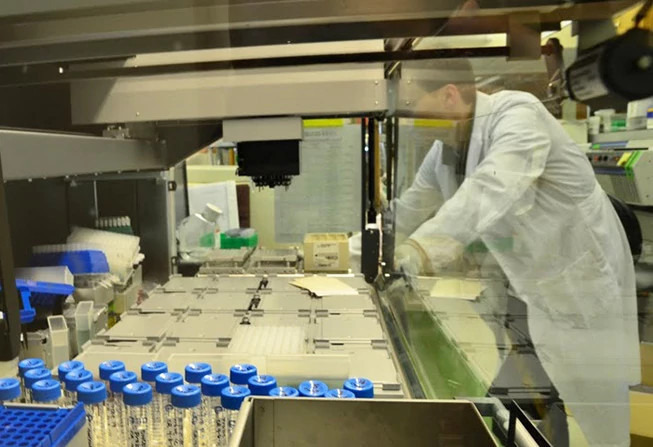Improvements to Single-Nucleus RNA-Seq Workflow
Single-nucleus RNA sequencing (snRNAseq) allows for the measurement of cell-type composition and cell-to-cell gene expression variation in frozen samples. Contrary to single-cell RNA sequencing, which requires fresh tissue, snRNAseq can be used for retrospective studies, benefiting from readily available frozen tissue collections. As multiple frozen samples can be processed simultaneously and the same nuclei isolation protocol works across variety of tissue types, snRNAseq has the potential of reducing experimental batch effects — for instance, when comparing treatment timepoints or multiple tumors from the same patient.
The current snRNAseq workflow, however, is labor-intensive, as each sample has to be processed one-at-a-time. To fully take advantage of snRNA-Seq benefits, we are currently testing ways to increase the throughput of our workflow using automated dry pulverization of frozen tissue with the Covaris cryoPREP system prior to nuclei isolation. Another benefit of this approach is that it would allow us to homogenize frozen tissue prior to allocation to different molecular assays such as snRNAseq and Whole Exome Sequencing, thereby removing biological variability between these assays.
Piloting Single-Nucleus Epigenome and Transcriptome Profiling
Single-cell multiome ATAC and RNA sequencing is a recently developed technology from 10x Genomics that enables simultaneous profiling of both the transcriptome and epigenome in single cells and nuclei, with the promise of gaining insight not only on the current state of a cell, but also on the mechanisms regulating it. We will soon be testing this technology on frozen tumor samples, benchmarking it against our well-established protocol for single-nucleus RNA sequencing, and evaluating the compatibility of different nuclei isolation protocols.
Cell-Free DNA
Solid tumor biopsies are expensive and invasive, making them less than ideal for patients who are older or very young. Furthermore, with certain forms of cancer such as non-small cell lung cancer, solid tumor biopsies are not obtainable for a significant number of patients, or do not have sufficient DNA to perform NGS profiling. CCG has extensive experience with cfDNA sequencing and is familiar with the technical characteristics that make it a challenging input. We have developed and refined our library construction and hybrid capture enrichment assays to achieve greater sensitivity. We are in the process of further refining our bioinformatics analysis workflow to take advantage of unique molecular identifiers for error detection at low tumor content.
RNA-Seq from FFPE Material
A fully automated RNA-Seq library construction method has been validated and used for collaborator projects at CCG. Further refinement and technical additions to the assay are ongoing, particularly with regard to developing methods for low input and poor-quality samples. Currently, we have restricted input to samples depleted of rRNA. However, future R&D efforts will be directed to using total RNA as input. CCG is also optimizing targeted (hybrid capture) RNA sequencing for expression analyses and detection of expressed structural variants. Our Bioinformatics Team has developed a data analysis workflow that includes expression analysis and fusion transcript detection.
Oxford Nanopore Sequencing
Long-read sequencing would be particularly well-suited to detect structural rearrangements and would not require a priori knowledge of where the rearrangement may have occurred. We have conducted a preliminary evaluation of the Oxford MinION and were able to achieve read lengths up to 50,000 base-pairs. The library construction and sequencing processes are relatively straightforward. While bioinformatic analysis tools are limited, there have been significant strides within the Nanopore community. Sequencing quality is problematic for homopolymer regions and artifactual indels are a systemic issue, both of which tend to restrict usage for SNV calling. The platform is not currently robust enough for clinical use and can be finnicky for research purposes, but it holds a great deal of promise.
CCG is testing how to enrich for specific genomic regions for long-read sequencing. Conventional hybrid capture baits are limited to pulling down fragments whose length is approximately 2 kb or less. One such method being tested is Cas9 to bind to and pull-down large fragments of ~10 Kb (Gilpatrick et al., 2020). Results are promising, but the method is still under development.
Gilpatrick T, Lee I, Graham JE, Raimondeau E, Bowen R, Heron A, Downs B, Sukumar S, Sedlazeck FJ, Timp W. “Targeted nanopore sequencing with Cas9-guided adapter ligation.” Nat Biotechnol. 2020 Apr;38(4):433-438. doi: 10.1038/s41587-020-0407-5. Epub 2020 Feb 10. PMID: 32042167
